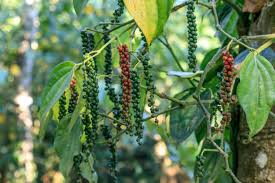The black pepper plant (Piper nigrum) is a flowering vine known for producing one of the world’s most popular and widely used spices—black pepper. Native to the tropical regions of South India, this plant thrives in hot and humid climates and is now cultivated across several parts of Asia, including Vietnam, Indonesia, and Sri Lanka. It belongs to the Piperaceae family and is prized not only for its culinary use but also for its health benefits and historical significance.
Growth and Cultivation
The black pepper plant is a perennial climbing vine that requires a support structure to grow effectively, such as trees, poles, or trellises. It grows best in well-drained, loamy soils rich in organic matter and prefers partial shade. The plant typically begins to flower in the second or third year after planting, with the peppercorns—small round fruits—maturing within six to eight months after flowering. The green peppercorns turn black when dried, becoming the familiar spice found in kitchens around the globe.
Propagation is usually done through stem cuttings rather than seeds, ensuring consistency in the plant’s yield and quality. Adequate irrigation, pruning, and organic mulching contribute to the healthy development of the vines and increase productivity. In many tropical areas, black pepper is often intercropped with crops like coffee and coconut, making efficient use of land and resources.
Culinary and Medicinal Uses
Black pepper is renowned for its sharp, spicy flavor and is a staple seasoning in countless cuisines. It is often used in ground form, but whole peppercorns are also employed in pickling, marinades, and spice blends. Beyond its culinary versatility, black pepper has a significant role in traditional medicine.
The active compound piperine is responsible for both its pungency and its therapeutic effects. Piperine is known to aid digestion by stimulating the stomach to produce more hydrochloric acid. It also enhances the bioavailability of certain nutrients and drugs, making it a popular additive in herbal supplements.
Studies suggest that black pepper may have antioxidant, anti-inflammatory, and antimicrobial properties. It is often used in Ayurvedic and Chinese medicine to treat ailments like sore throats, colds, and respiratory issues.
Economic and Environmental Importance
Black pepper is often referred to as the “King of Spices” and plays a vital role in the economies of the regions where it is grown. It has been a significant part of global trade for centuries and remains in high demand worldwide. In addition to its commercial value, the black pepper plant can contribute to sustainable agricultural practices when integrated thoughtfully into farming systems.
For those interested in natural plant extracts, essential oils, or botanical ingredients for wellness or industrial use, websites like superiorhydrola.com offer valuable resources on high-quality plant derivatives, including those from black pepper.
Conclusion
The black pepper plant is more than just a spice-producing vine. It embodies a rich history, robust health benefits, and vital economic value. Whether you grow it in a home garden or source it for culinary or medicinal use, the black pepper plant remains a cornerstone of both tradition and innovation in the botanical world.




